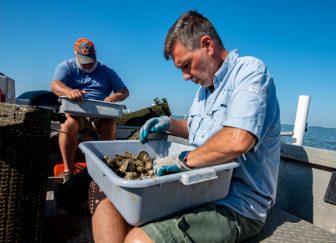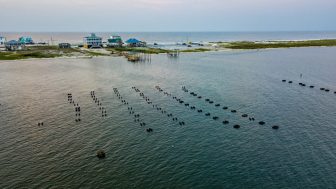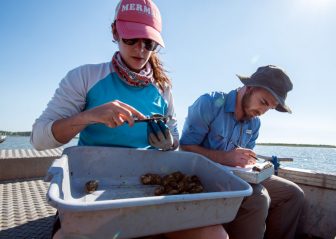Changing Climate: In Pursuit of the Disappearing Alabama Oyster. Will They Ever Return?
By Hank Black
Oysters, one of the vital signs of the health of Alabama’s coastal waters, were once a jewel of the state’s economy and a local delicacy. Now, wild oysters from the Mobile Bay area have almost entirely disappeared. With few exceptions, the oysters most of us now enjoy originate elsewhere.
Numbers tell the sad story: Wild oyster harvests from local reefs amounted to more than a million pounds annually in the early 1950s. In the one-week 2017 season, only a negligible amount was taken. And the 2018 season was cancelled due to the lack of young oysters found when the Marine Resources Division surveyed public reefs.
The Alabama Marine Resources Division announced Nov. 1 that limited areas of public oyster bottoms will be opened for harvest beginning Nov.11.
“Our surveys of the public oyster bottoms show that there are enough legal-size oysters in some areas to allow for a limited harvest,” said Scott Bannon, director of the division.
The cause of the collapse of the industry has many influences, not least of which is the destruction of oyster reefs by human hands. But other factors are attributed to climate change’s rising temperatures, more powerful storms, more torrential rains and increased acid in ocean waters. The secondary effects include poor water quality, changing salinity and low oxygen concentration.
Wild oysters grow in salty or brackish estuaries. Periods of extreme drought or more torrential rainfall, both associated with warming global temperatures, raise or lower salinity.
Bill Walton, director of the Auburn University Shellfish Lab and senior marine scientist at the Dauphin Island Sea Lab, said, “Oysters are pretty good at surviving in a range of salinity, but they don’t do well with sudden extreme swings.” They can survive at very low levels, but not for long, he said.
The salinity can be drastically diluted from rainfall and river water entering the bay. Oyster farmer Andy DePaola, a retired microbiologist who moved to the bay area in 1979, sees wild fluctuations in salinity from as high as 20 parts per thousand to less than 1 ppt within a couple of days. In 2017, he lost his entire crop after Hurricane Cindy’s rainfall flooded the watershed, diluting oyster estuaries. Fellow farmers on the eastern shore had oysters die earlier this year after saline levels fell to near zero at some areas of the bay due to major flooding on the Tombigbee River that continued for several months.
One of Walton’s greatest concerns about climate change is that ocean waters become more acidic as they absorb some of the carbon dioxide in the atmosphere. Globally, the pH of the world’s oceans has been reduced by 0.1, which is an increase of acidity of about 30 percent, according to a noaa.gov factsheets.
Increased acid is not yet as big a problem in the Gulf of Mexico as elsewhere, but higher pH would spell disaster for shellfish, because it corrodes the calcium carbonate of their armor. That would be even more problematic for the thinner, almost translucent shells of the oyster larvae. Walton said Pacific Northwest oyster nurseries have been undermined by rising acid in their habitat, with “dramatic implications” for the future of the industry in Alabama.
Water Quality
Spring gully-washer rains that flush water down rivers and into the bay also carry human waste and chemicals from overwhelmed treatment facilities and from wild animals and farming operations. The concentration of harmful bacteria in the bay from this detritus can make oysters unsafe to eat. Bacteria are monitored closely by public health officials, who can close all oyster harvesting for weeks.
Closures occurred seven times in 2019, the latest being Sept. 20-26.
Swimmers aren’t safe, either. The Mobile Baykeeper organization monitors popular swimming areas of the bay for bacterial conditions and issues regular alerts about polluted areas.
Harmful bacteria isn’t all that inhibits swimmers.
“Nobody gets in the water from the western shore of the bay anymore,” DePaola said. “Their piers have been swept away by storms, and sandy beaches have eroded because people put up seawalls causing massive waves from big ships in the channel to dig away at their foundations.”

Michael Clemmer
Auburn University professor Dr. Bill Walton.
Years ago when less than 20 percent of the shore was hardened with seawalls, he could walk a nearly mile-long sand strand several feet above sea level. The sand is almost gone, eroded, along with vast, intertidal expanses that promoted diverse aquatic life. It’s been replaced with murky waters a foot or two deep along much of the shore so that sand bars are seldom seen at low tide, DePaola said. Rising sea levels pose even more of a threat to hardened shorelines, he said.
In 2018, global mean sea level was 3.2 inches (81 millimeters) above the 1993 average. On the Alabama coast, the Gulf has risen at least 7.5 inches since 1966, with seas rising faster in recent years, according to educator Sonia Vedral of the Northern Gulf of Mexico Sentinel Site Cooperative, which operates a data collection site on Dauphin Island.
Reef Destruction
Alabama reefs are in recovery from physical damage and silting caused by hurricanes, effects that have changed the dynamics of Mobile Bay, according to the nonprofit group, The Nature Conversancy. The reefs help prevent erosion of marshland and shoreline from waves brought by storms, wind and ships.
Physical damage to reefs includes past dredging for oysters, as well as from contractors who the state allowed to quarry the reefs for use as aggregate in concrete and roadbeds. The practice went on for more than 20 years, until 1968. By then, much of Mobile Bay’s bottom was a muddy mess where no oyster could survive.
Climate change can’t be blamed for dredging and extraction of the reefs, but more intense tropical storms and hurricanes continue to churn the silty bottom, turning the once-clear waters opaque.
“I haven’t seen any studies that show the problem is absolutely just ‘X’,” Walton said, “so I think it’s more the combination of things.”
His lab, a consortium of universities across Mississippi and Alabama, the Marine Resources Division and others are tasked with identifying bottlenecks that prevent the comeback of wild oysters.
“Some interesting work out of the Dauphin Island Sea Lab shows that we may need to build new reefs higher, above low-oxygen layers at the bottom,” Walton said.
The Oyster Farmers
Though no one has yet pinpointed how to reestablish wild oyster beds, the early success of oyster farming encourages Walton to believe oysters eventually will thrive in the bay.
“Farmers are growing some beautiful oysters up off the bottom in mesh baskets, where predators can’t get to them,” he said. “That gives me hope that we can find a way forward” to the return of wild oysters.

Michael Clemmer
Experimental oyster farm on the west end of Dauphin Island.
DePaola on the western shore and Michael Ludvigsen on the eastern are avid proponents for the oyster farming industry, which now comprises almost 20 licensed farmers and others who grow for personal consumption.
Farmers buy oyster babies and grow them in baskets suspended from piers a few inches above the shallow, squishy bay floor. Every week the baskets must be raised for 24 hours to air dry, which prevents damage from algae, barnacles, and other organisms that can foul the oysters.
Most farmers heft their baskets by hand. DePaola, however, developed and patented a compressed air device called a Shellevator to do the work. It can also be towed away to escape floods and pollution or sunk to withstand storms.
Farming has its ups and downs in changing times. Recently, oysters have been taking longer to grow to the optimum size that brings a premium price. DePaola blames it on worsening water conditions, particularly on low oxygen levels, called hypoxia. Upstream runoff into rivers and streams from agricultural and residential fertilizers help fuel harmful algae blooms and hypoxia.
The condition is exacerbated, he said, when huge ships whip up hypoxic waters and sediment from the bottom of the navigation channel and push it in powerful waves to the shore. Even more powerful waves can be expected now that officials have approved dredging the channel 100 feet wider and 50 feet deeper to allow two-way traffic of container and cruise vessels.
Hypoxic conditions are integral to the bay’s famous “seafood jubilees,” which once were annual events on the western shore but now occur multiple times a year, DePaola said. He held up a flounder gigged in that morning’s jubilee.
Ludvigen, whose family has lived on Bon Secour Bay for generations, also wonders about those oxygen levels.
“As days gets warmer, there’s more silt in the water that retains and builds even more heat, and there’s overall lower oxygen because of it,” he said.
He sees less bottom-feeding life in the bay, where he suspects a layer of low-oxygen water exists.
“We see fewer crabs, and don’t see them at depth. And charter boat captains might catch one flounder a week, when they used to get three or four every trip out,” he said.
“It’s hard to know exactly how warming waters is affecting oysters,” Walton said, “but among projected impacts are extension of the growing season and number of spawning days.” On the downside, peak temperatures of summer increase their energy demands, including food requirements, he said.
“Another concern is that (warm) water is not as good at holding onto oxygen, and (lower oxygen level) is a real stress on basically anything living in the water,” he added. The effect increases in the peak of summer heat. Lower oxygen causes shellfish energy demands to rise and increases the threat from oyster drills and other predators.
Ludvigsen doesn’t expect wild oysters to return to the bay in harvestable levels in his lifetime so supply must come from oyster farms.
The question for him is whether there are good answers for the effects of climate change: more extreme storms and torrential rain leading to the increased flow of fresh water into the bay, and more runoff and overflow of sewage and bacteria.

Michael Clemmer
Danielle Aguilar Marshall and Nick Coxe, LSU students measure oysters.
“Two years ago, we were closed for almost half of the year and that put a couple of guys out of business,” he said. “And because the size of our shell is what makes our market, closing for five or six weeks moves a lot of our shell out of the (premium) and into the low-end line. Overall it kills us.”
He fears the coastal ecology, particularly the bay, already is so fragile that just one devastating hurricane or other catastrophe could push it past ever regaining its health. He points to the struggle to restore the oyster reefs and replenish them.
“Auburn’s been struggling to bring them back, and you can’t quite see why it’s not working. There’s the overall health of the waters, but another problem is with the numbers they’re dealing with. Fifty years ago there were hundreds of millions of oysters in the bay. So if they put two or three million (oyster larvae) into a reef, that’s nothing,” he said.
Is Washington Listening?
Oystering has been in Ludvigen’s family for six generations on the south shore of Bon Secour Bay. He is active in the recently formed Shellfish Growers Climate Change Coalition in partnership with The Nature Conservancy. It includes farmers from east, west and Gulf coasts.
In that role he briefed the Senate Commerce Committee’s climate change adviser a few months ago. He was shocked at the response he got from his warnings about climate.
“I talked to Democrats and Republicans, and nobody’s denying it any more. Most of their comments were, ‘How much money do we need?’ and ‘What kind of legislation would help?’”
Ludvigen said, “Everybody’s been denying climate change for so long that there’s an immediate need for more data collection to show actual impact. That data should go to a group of top scientists and economists, as well as ‘regular people with real-world knowledge,’ who would be charged with developing a plan of action.
Long-term solutions might include a tax on carbon as a way to reduce emissions, “but you can cut all you want today and it won’t have an impact tomorrow. That would be way down the road.”
Rising sea levels and warming temperatures are essentially out of immediate human control, he said, but mitigation of storm water and sanitary sewer systems are closer at hand. That’s a matter he knows something about from 29 years of consulting for utilities in the Midwest before returning home eight years ago.
Deferred maintenance has devastated the infrastructure, he said.
Will Wild Oysters Return?
Efforts to improve conditions for oysters in the bay continue. Among them is a state reef enhancement program, funded from money received from sales by oystermen. It plants shells collected from local processors on reefs in public waters. And through an “oyster gardening” program of the Alabama Cooperative Extension Service and partners, volunteers with waterfront property grow oysters that are planted on reefs in the bay and the Mississippi Sound each year.
Will they succeed in restoring the reefs and the oysters? The jury is out. But there’s no question the bay’s health would be greatly improved if so, for oysters play an outsized role in filtering excess pollutants, increasing habitat for game fish and providing food and shelter for hundreds of species of marine organisms.
Over the next year, BirminghamWatch will visit places in Alabama where ways of life have been affected as climate changes and look at what’s being done to mitigate or avoid the effects. This is the third in a series of four stories from Alabama’s Gulf Coast. Read the earlier stories: Changing Climate: Alabama Sees Heat, Storms, Drought and Turtles; Cloudy Future for Dauphin Island, a Canary in the Coal Mine of Climate Change
Editor Note: This story has been changed to correct the name of Danielle Aguilar Marshall, an LSU student, in one of the cutlines.
Birmingham is 3rd worst in the Southeast for ozone pollution, new report says
The American Lung Association's "State of the Air" report shows some metro areas in the Gulf States continue to have poor air quality.
Why haven’t Kansas and Alabama — among other holdouts — expanded access to Medicaid?
Only 10 states have not joined the federal program that expands Medicaid to people who are still in the "coverage gap" for health care
Once praised, settlement to help sickened BP oil spill workers leaves most with nearly nothing
Thousands of ordinary people who helped clean up after the 2010 BP oil spill in the Gulf of Mexico say they got sick. A court settlement was supposed to help compensate them, but it hasn’t turned out as expected.
Q&A: How harm reduction can help mitigate the opioid crisis
Maia Szalavitz discusses harm reduction's effectiveness against drug addiction, how punitive policies can hurt people who need pain medication and more.
The Gulf States Newsroom is hiring a Community Engagement Producer
The Gulf States Newsroom is seeking a curious, creative and collaborative professional to work with our regional team to build up engaged journalism efforts.
Gambling bills face uncertain future in the Alabama legislature
This year looked to be different for lottery and gambling legislation, which has fallen short for years in the Alabama legislature. But this week, with only a handful of meeting days left, competing House and Senate proposals were sent to a conference committee to work out differences.








